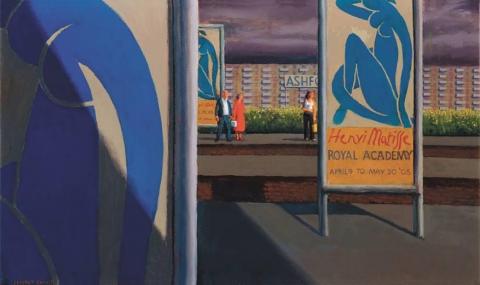SECOND STUDY FOR MATISSE AT ASHFORD, 2004
JEFFREY SMART
oil on canvas
39.5 x 66.5 cm
signed lower left: JEFFREY SMART
Australian Galleries, Sydney (label attached verso)
Private collection, Sydney
Private collection, Sydney, acquired from the above in 2011
Jeffrey Smart, Paintings and Studies 2004 – 2006, Australian Galleries, Melbourne, 28 September – 8 October, 2006 and Australian Galleries, Sydney, 17 October – 4 November, 2006, cat. 10
Allen, C., Jeffrey Smart, Paintings and Studies 2004 – 2006, Australian Galleries, Melbourne, 2006, p. 37 (illus.)
Matisse at Ashford, 2004, oil on canvas, 86.0 x 138.0 cm, collection of the Art Gallery of New South Wales, Sydney, in Pearce, B., Jeffrey Smart, Beagle Press, Sydney, revised edition 2011 (illus. on cover)
Second Study for Matisse at Ashford 2004 is a classic Jeffrey Smart in composition, imagery, and inspiration. Developed through two oil studies, Smart attains his characteristic perfection through his beloved golden section, of compositional balance and interplay of verticals and horizontals. The emphasis on the picture plane is contrasted with the recession of the posters into a distant background of apartments in serried ranks of sameness. The figures, as Smart has often remarked, are there for scale, bright touches of colour amid the encroaching evening blues. While the autobahns and road signs have been replaced with platforms and large posters, Smart's fascination with things to do with travel is present in this stationary view from a railway carriage.The inspiration is Ashford station in Kent, the first British stop for the Eurostar in its Paris-London trip under the British Channel. That ever present element of expectation is provided by the darkening afternoon light, casting its enigmatic shadows. They seem to take on lives of their own. The posters for the Henri Matisse exhibition at London's Royal Academy add a series of further bizarre notes, the sinuous, blue figures of the Matisse nude contrasting with the rectilinear organization of the other forms. Smart was on his way to London when the train's pause at Ashford gave him the idea for the painting, quickly sketched in pen and ink. Back in his studio near Arezzo in Tuscany, the sketch grew into the first study in oil in which the basic ideas and forms were painted on a canvas of 38 by 54 centimeters. This was followed by our painting, which is slightly larger, figures positioned as in the final painting, a line of yellow flowering bushes introduced, and individual shadows placed more exactly. The differences between this second study and the larger painting in the collection of the Art Gallery of New South Wales are mainly ones of detail and size. A rubbish bin has been added to the right in the far platform and the flowers changed into a low hedge. While the homage to the great Matisse nude cut-out is obvious, the close presence of the rubbish bin is not. Irony is an on-going element in his art. Despite Smart's protestations that his art is all about formal qualities, his paintings view the contemporary world with a quizzical look beneath the surfaces of things. Unlike the prophets of old, Smart eschews the wilderness for the urban scene, Second Study for Matisse at Ashford providing a fascinating introduction and complement to one of his later masterpieces.
DAVID THOMAS
